Construction Practice and Management Report - Unit 4: Practice
VerifiedAdded on 2022/08/25
|17
|3836
|63
Report
AI Summary
This report provides a comprehensive analysis of construction practice and management, focusing on the transition of a construction company from small-scale to mega-scale projects. It explores key aspects such as professionalism in the industry, including value management, risk management, and supply chain management. The report delves into different types of construction companies, including civil engineering, general contractors, and industrial infrastructure sectors, highlighting their roles and relationships. It also examines modern construction techniques, such as building information modeling (BIM) and contract planning, crucial for efficient project execution. The report covers various contract types and tender processes, providing insights into effective bid management and supplier selection. Furthermore, it discusses the importance of professionalism, risk management, and supply chain management in ensuring successful project outcomes, particularly for companies undertaking mega projects. The report is structured into four sections, offering a detailed breakdown of these topics to facilitate understanding and practical application within the construction industry.
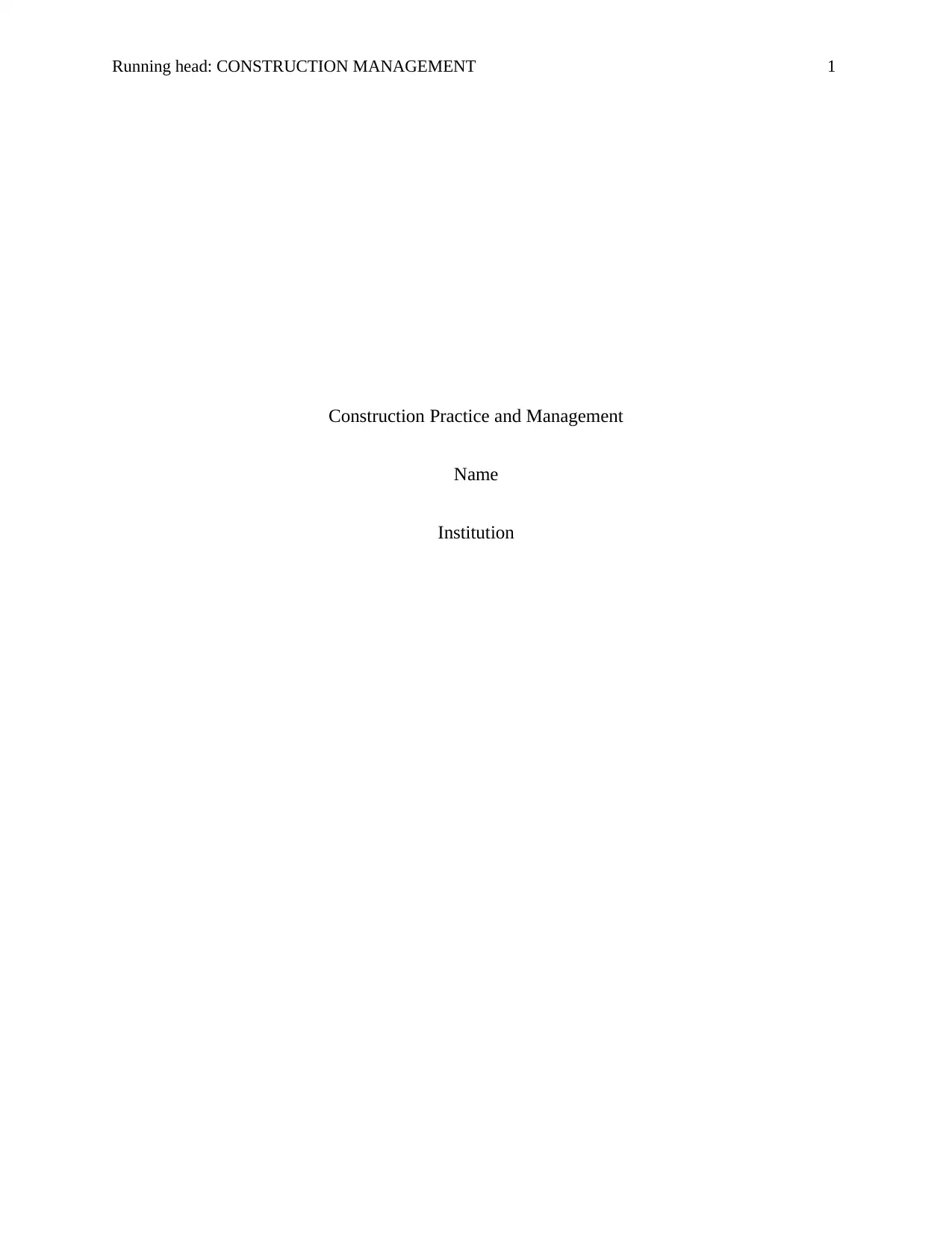
Running head: CONSTRUCTION MANAGEMENT 1
Construction Practice and Management
Name
Institution
Construction Practice and Management
Name
Institution
Paraphrase This Document
Need a fresh take? Get an instant paraphrase of this document with our AI Paraphraser
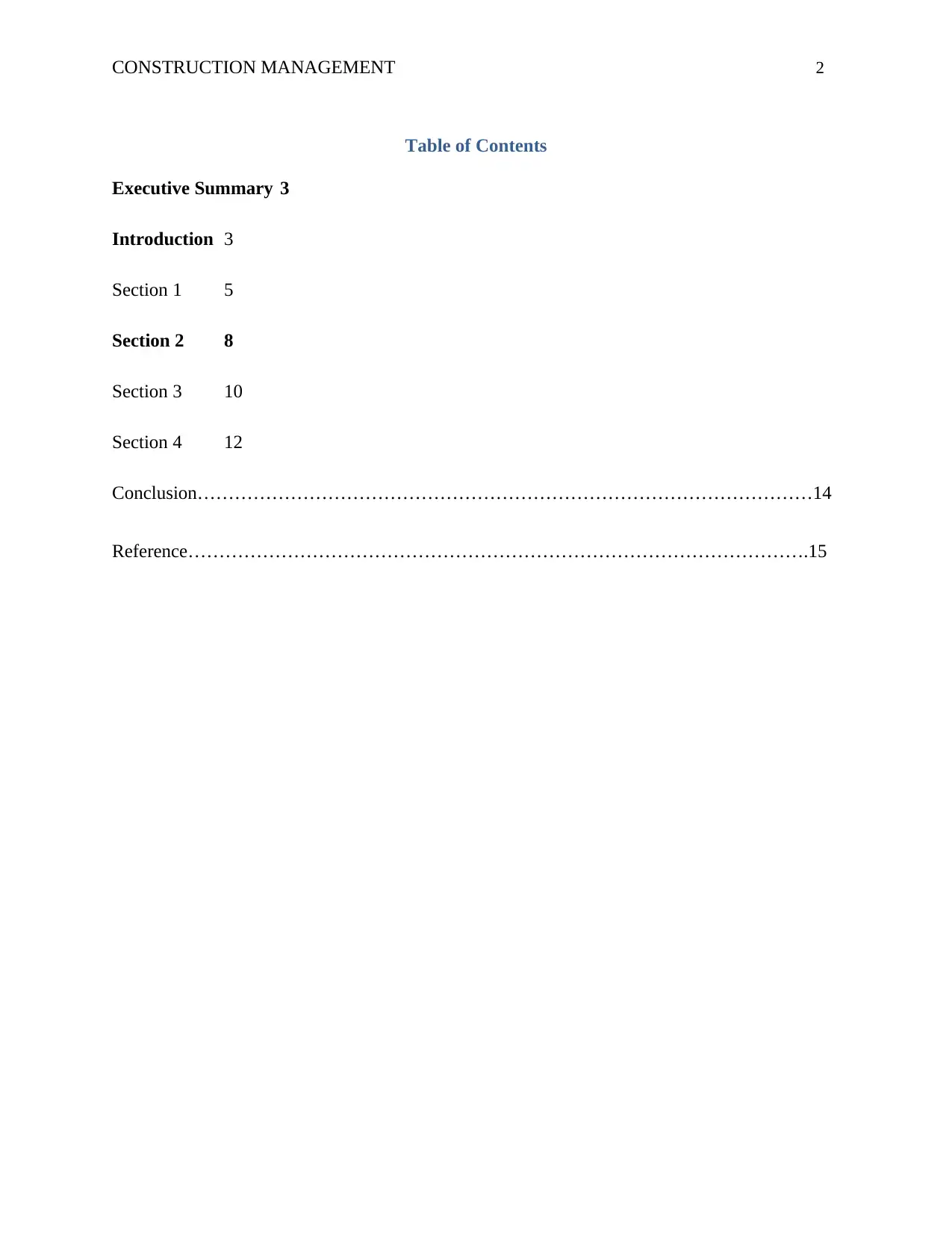
CONSTRUCTION MANAGEMENT 2
Table of Contents
Executive Summary 3
Introduction 3
Section 1 5
Section 2 8
Section 3 10
Section 4 12
Conclusion………………………………………………………………………………………14
Reference……………………………………………………………………………………….15
Table of Contents
Executive Summary 3
Introduction 3
Section 1 5
Section 2 8
Section 3 10
Section 4 12
Conclusion………………………………………………………………………………………14
Reference……………………………………………………………………………………….15
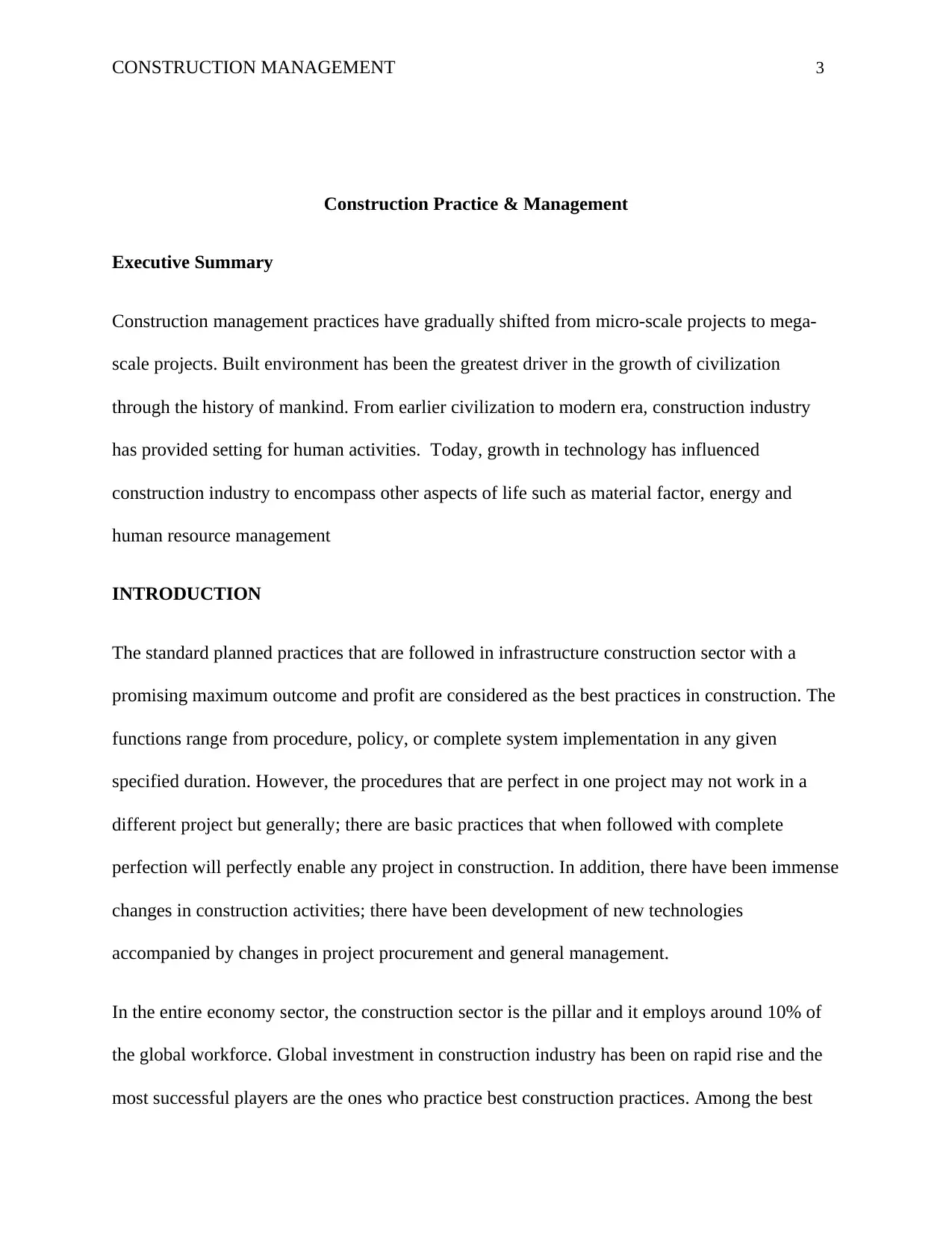
CONSTRUCTION MANAGEMENT 3
Construction Practice & Management
Executive Summary
Construction management practices have gradually shifted from micro-scale projects to mega-
scale projects. Built environment has been the greatest driver in the growth of civilization
through the history of mankind. From earlier civilization to modern era, construction industry
has provided setting for human activities. Today, growth in technology has influenced
construction industry to encompass other aspects of life such as material factor, energy and
human resource management
INTRODUCTION
The standard planned practices that are followed in infrastructure construction sector with a
promising maximum outcome and profit are considered as the best practices in construction. The
functions range from procedure, policy, or complete system implementation in any given
specified duration. However, the procedures that are perfect in one project may not work in a
different project but generally; there are basic practices that when followed with complete
perfection will perfectly enable any project in construction. In addition, there have been immense
changes in construction activities; there have been development of new technologies
accompanied by changes in project procurement and general management.
In the entire economy sector, the construction sector is the pillar and it employs around 10% of
the global workforce. Global investment in construction industry has been on rapid rise and the
most successful players are the ones who practice best construction practices. Among the best
Construction Practice & Management
Executive Summary
Construction management practices have gradually shifted from micro-scale projects to mega-
scale projects. Built environment has been the greatest driver in the growth of civilization
through the history of mankind. From earlier civilization to modern era, construction industry
has provided setting for human activities. Today, growth in technology has influenced
construction industry to encompass other aspects of life such as material factor, energy and
human resource management
INTRODUCTION
The standard planned practices that are followed in infrastructure construction sector with a
promising maximum outcome and profit are considered as the best practices in construction. The
functions range from procedure, policy, or complete system implementation in any given
specified duration. However, the procedures that are perfect in one project may not work in a
different project but generally; there are basic practices that when followed with complete
perfection will perfectly enable any project in construction. In addition, there have been immense
changes in construction activities; there have been development of new technologies
accompanied by changes in project procurement and general management.
In the entire economy sector, the construction sector is the pillar and it employs around 10% of
the global workforce. Global investment in construction industry has been on rapid rise and the
most successful players are the ones who practice best construction practices. Among the best
⊘ This is a preview!⊘
Do you want full access?
Subscribe today to unlock all pages.

Trusted by 1+ million students worldwide
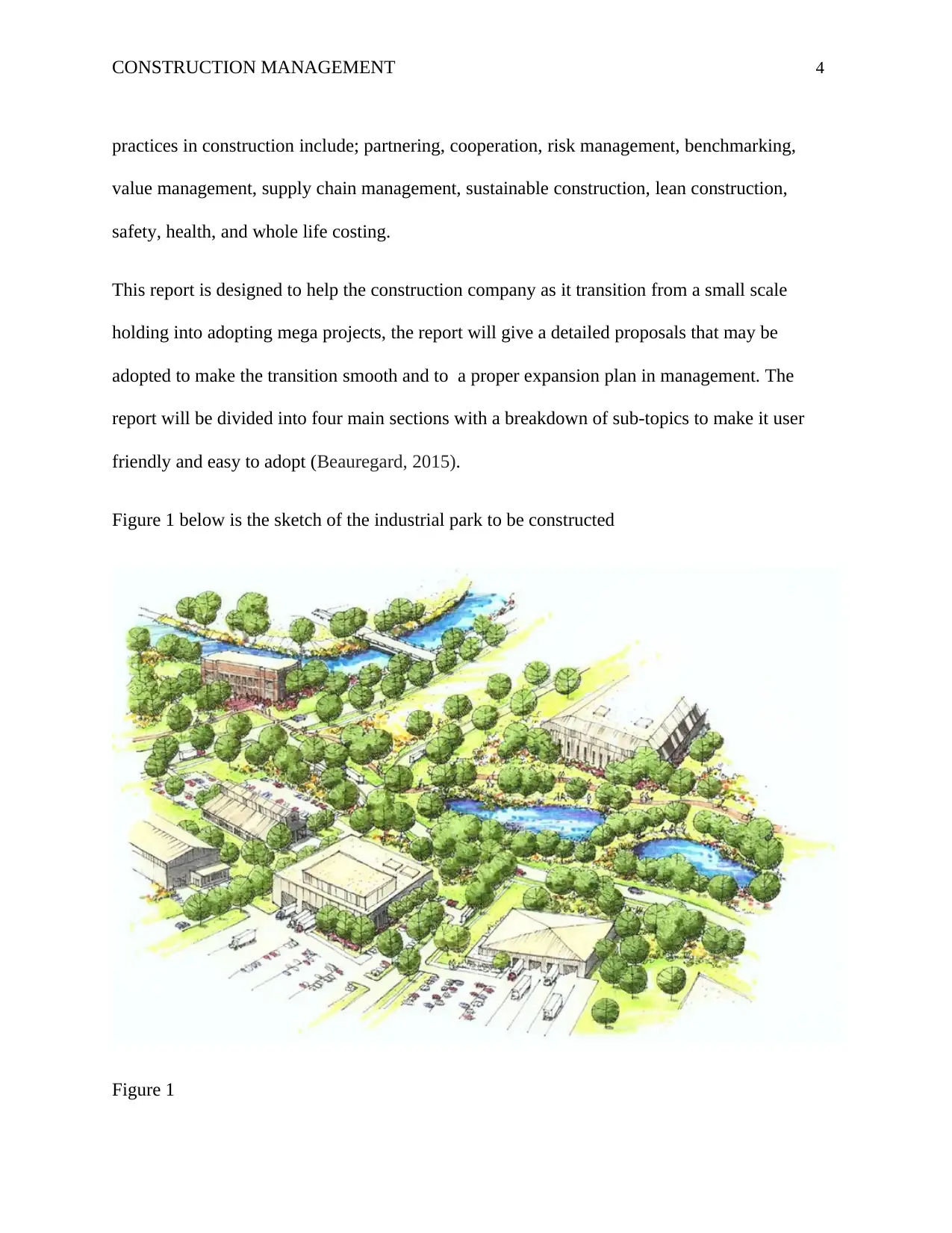
CONSTRUCTION MANAGEMENT 4
practices in construction include; partnering, cooperation, risk management, benchmarking,
value management, supply chain management, sustainable construction, lean construction,
safety, health, and whole life costing.
This report is designed to help the construction company as it transition from a small scale
holding into adopting mega projects, the report will give a detailed proposals that may be
adopted to make the transition smooth and to a proper expansion plan in management. The
report will be divided into four main sections with a breakdown of sub-topics to make it user
friendly and easy to adopt (Beauregard, 2015).
Figure 1 below is the sketch of the industrial park to be constructed
Figure 1
practices in construction include; partnering, cooperation, risk management, benchmarking,
value management, supply chain management, sustainable construction, lean construction,
safety, health, and whole life costing.
This report is designed to help the construction company as it transition from a small scale
holding into adopting mega projects, the report will give a detailed proposals that may be
adopted to make the transition smooth and to a proper expansion plan in management. The
report will be divided into four main sections with a breakdown of sub-topics to make it user
friendly and easy to adopt (Beauregard, 2015).
Figure 1 below is the sketch of the industrial park to be constructed
Figure 1
Paraphrase This Document
Need a fresh take? Get an instant paraphrase of this document with our AI Paraphraser
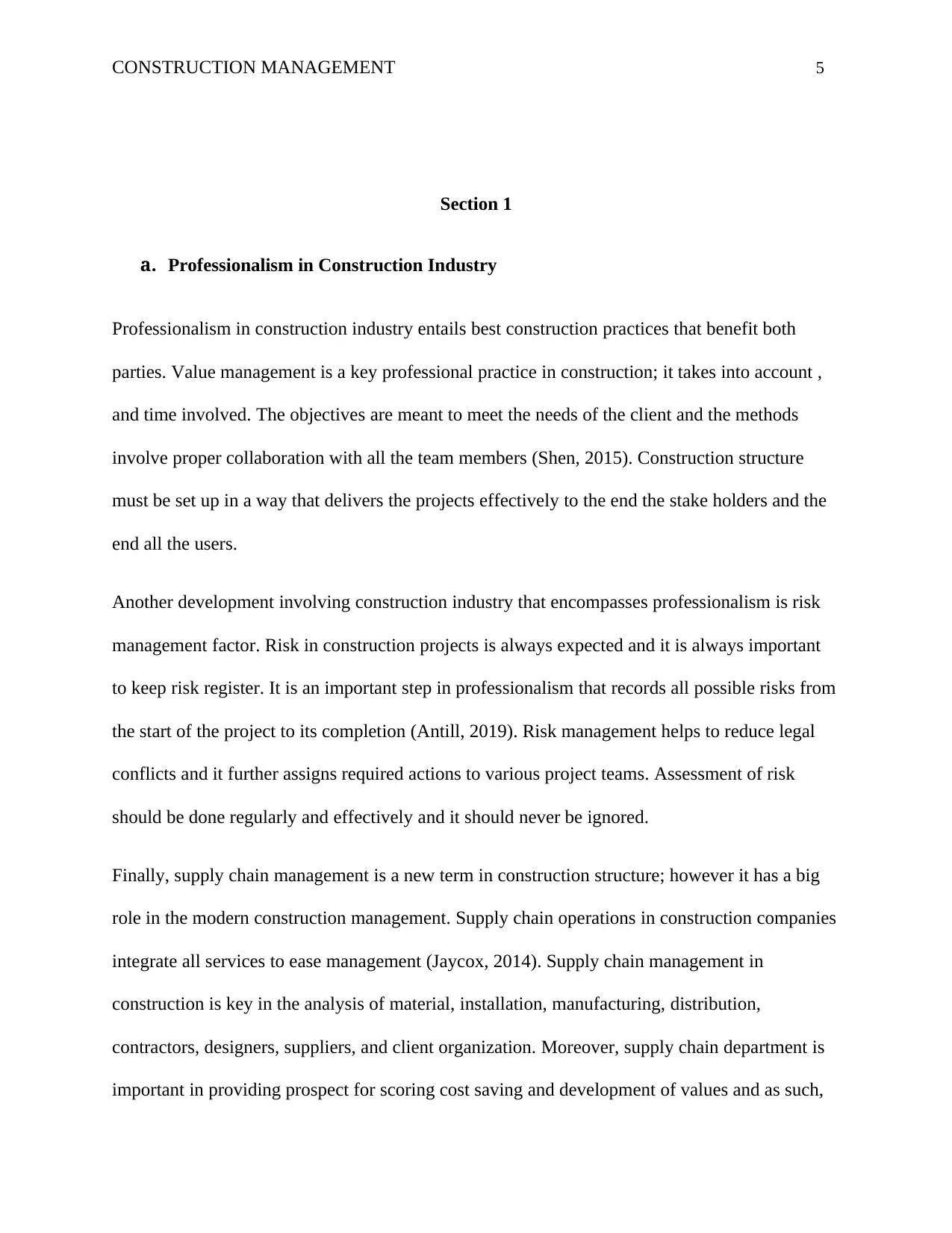
CONSTRUCTION MANAGEMENT 5
Section 1
a. Professionalism in Construction Industry
Professionalism in construction industry entails best construction practices that benefit both
parties. Value management is a key professional practice in construction; it takes into account ,
and time involved. The objectives are meant to meet the needs of the client and the methods
involve proper collaboration with all the team members (Shen, 2015). Construction structure
must be set up in a way that delivers the projects effectively to the end the stake holders and the
end all the users.
Another development involving construction industry that encompasses professionalism is risk
management factor. Risk in construction projects is always expected and it is always important
to keep risk register. It is an important step in professionalism that records all possible risks from
the start of the project to its completion (Antill, 2019). Risk management helps to reduce legal
conflicts and it further assigns required actions to various project teams. Assessment of risk
should be done regularly and effectively and it should never be ignored.
Finally, supply chain management is a new term in construction structure; however it has a big
role in the modern construction management. Supply chain operations in construction companies
integrate all services to ease management (Jaycox, 2014). Supply chain management in
construction is key in the analysis of material, installation, manufacturing, distribution,
contractors, designers, suppliers, and client organization. Moreover, supply chain department is
important in providing prospect for scoring cost saving and development of values and as such,
Section 1
a. Professionalism in Construction Industry
Professionalism in construction industry entails best construction practices that benefit both
parties. Value management is a key professional practice in construction; it takes into account ,
and time involved. The objectives are meant to meet the needs of the client and the methods
involve proper collaboration with all the team members (Shen, 2015). Construction structure
must be set up in a way that delivers the projects effectively to the end the stake holders and the
end all the users.
Another development involving construction industry that encompasses professionalism is risk
management factor. Risk in construction projects is always expected and it is always important
to keep risk register. It is an important step in professionalism that records all possible risks from
the start of the project to its completion (Antill, 2019). Risk management helps to reduce legal
conflicts and it further assigns required actions to various project teams. Assessment of risk
should be done regularly and effectively and it should never be ignored.
Finally, supply chain management is a new term in construction structure; however it has a big
role in the modern construction management. Supply chain operations in construction companies
integrate all services to ease management (Jaycox, 2014). Supply chain management in
construction is key in the analysis of material, installation, manufacturing, distribution,
contractors, designers, suppliers, and client organization. Moreover, supply chain department is
important in providing prospect for scoring cost saving and development of values and as such,
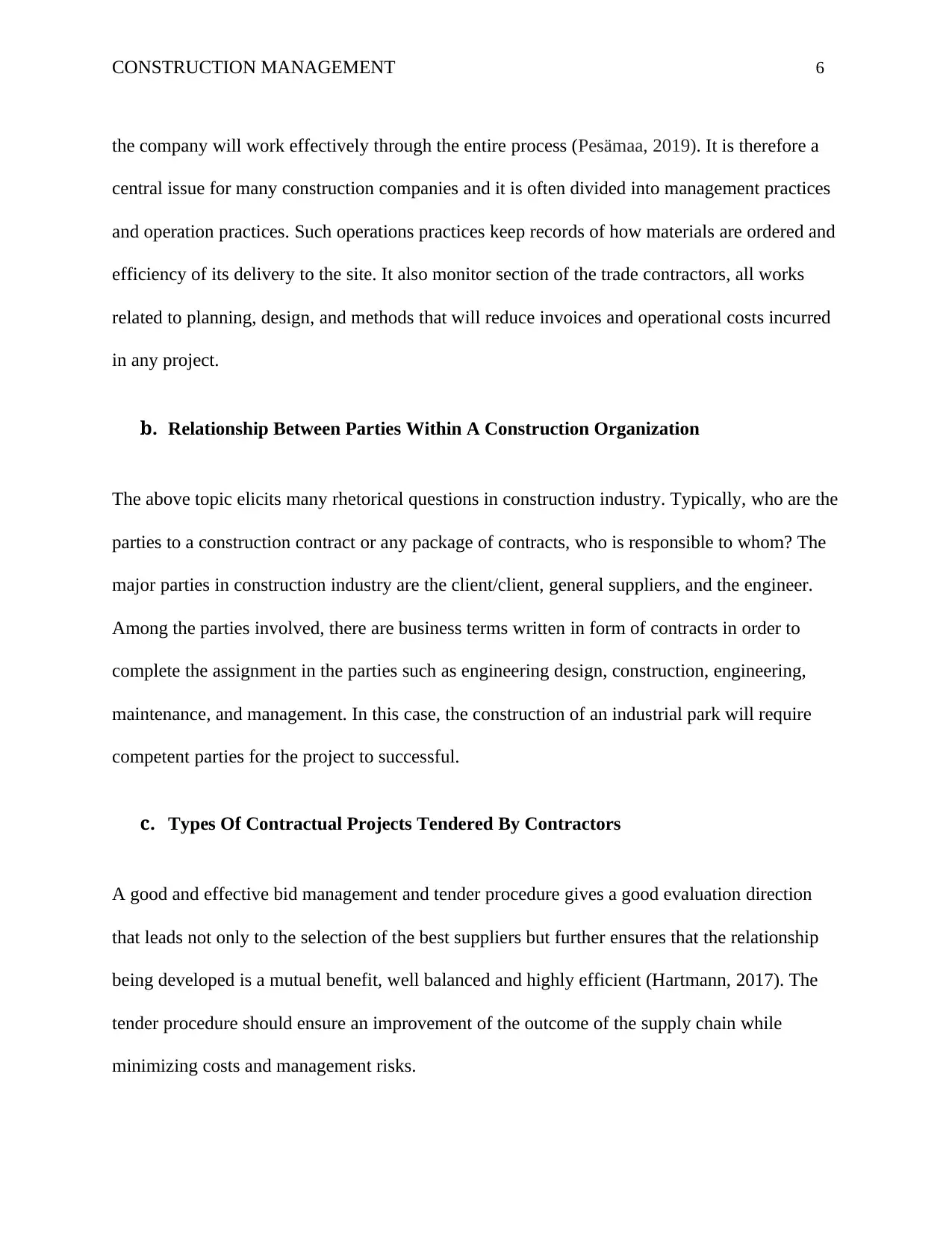
CONSTRUCTION MANAGEMENT 6
the company will work effectively through the entire process (Pesämaa, 2019). It is therefore a
central issue for many construction companies and it is often divided into management practices
and operation practices. Such operations practices keep records of how materials are ordered and
efficiency of its delivery to the site. It also monitor section of the trade contractors, all works
related to planning, design, and methods that will reduce invoices and operational costs incurred
in any project.
b. Relationship Between Parties Within A Construction Organization
The above topic elicits many rhetorical questions in construction industry. Typically, who are the
parties to a construction contract or any package of contracts, who is responsible to whom? The
major parties in construction industry are the client/client, general suppliers, and the engineer.
Among the parties involved, there are business terms written in form of contracts in order to
complete the assignment in the parties such as engineering design, construction, engineering,
maintenance, and management. In this case, the construction of an industrial park will require
competent parties for the project to successful.
c. Types Of Contractual Projects Tendered By Contractors
A good and effective bid management and tender procedure gives a good evaluation direction
that leads not only to the selection of the best suppliers but further ensures that the relationship
being developed is a mutual benefit, well balanced and highly efficient (Hartmann, 2017). The
tender procedure should ensure an improvement of the outcome of the supply chain while
minimizing costs and management risks.
the company will work effectively through the entire process (Pesämaa, 2019). It is therefore a
central issue for many construction companies and it is often divided into management practices
and operation practices. Such operations practices keep records of how materials are ordered and
efficiency of its delivery to the site. It also monitor section of the trade contractors, all works
related to planning, design, and methods that will reduce invoices and operational costs incurred
in any project.
b. Relationship Between Parties Within A Construction Organization
The above topic elicits many rhetorical questions in construction industry. Typically, who are the
parties to a construction contract or any package of contracts, who is responsible to whom? The
major parties in construction industry are the client/client, general suppliers, and the engineer.
Among the parties involved, there are business terms written in form of contracts in order to
complete the assignment in the parties such as engineering design, construction, engineering,
maintenance, and management. In this case, the construction of an industrial park will require
competent parties for the project to successful.
c. Types Of Contractual Projects Tendered By Contractors
A good and effective bid management and tender procedure gives a good evaluation direction
that leads not only to the selection of the best suppliers but further ensures that the relationship
being developed is a mutual benefit, well balanced and highly efficient (Hartmann, 2017). The
tender procedure should ensure an improvement of the outcome of the supply chain while
minimizing costs and management risks.
⊘ This is a preview!⊘
Do you want full access?
Subscribe today to unlock all pages.

Trusted by 1+ million students worldwide
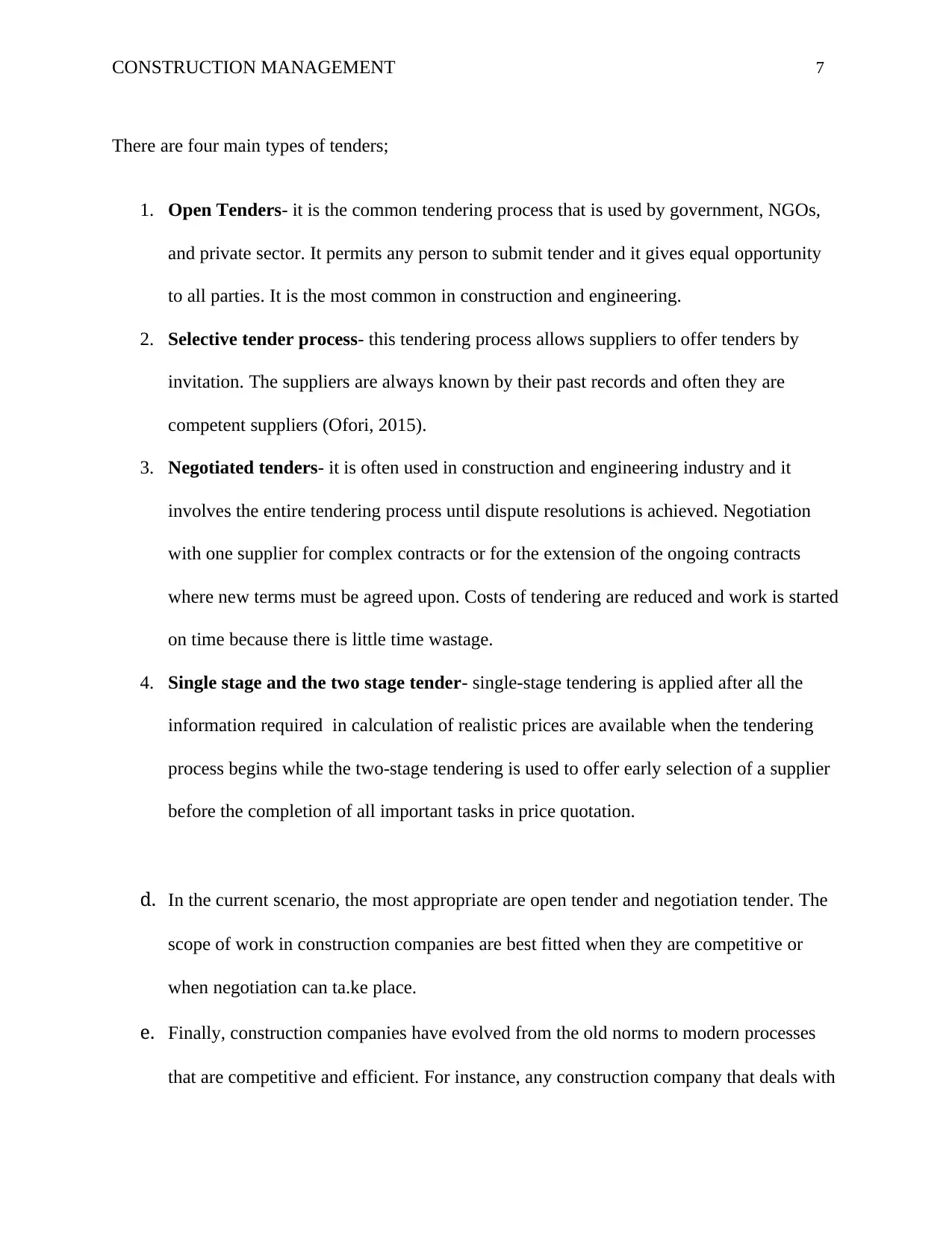
CONSTRUCTION MANAGEMENT 7
There are four main types of tenders;
1. Open Tenders- it is the common tendering process that is used by government, NGOs,
and private sector. It permits any person to submit tender and it gives equal opportunity
to all parties. It is the most common in construction and engineering.
2. Selective tender process- this tendering process allows suppliers to offer tenders by
invitation. The suppliers are always known by their past records and often they are
competent suppliers (Ofori, 2015).
3. Negotiated tenders- it is often used in construction and engineering industry and it
involves the entire tendering process until dispute resolutions is achieved. Negotiation
with one supplier for complex contracts or for the extension of the ongoing contracts
where new terms must be agreed upon. Costs of tendering are reduced and work is started
on time because there is little time wastage.
4. Single stage and the two stage tender- single-stage tendering is applied after all the
information required in calculation of realistic prices are available when the tendering
process begins while the two-stage tendering is used to offer early selection of a supplier
before the completion of all important tasks in price quotation.
d. In the current scenario, the most appropriate are open tender and negotiation tender. The
scope of work in construction companies are best fitted when they are competitive or
when negotiation can ta.ke place.
e. Finally, construction companies have evolved from the old norms to modern processes
that are competitive and efficient. For instance, any construction company that deals with
There are four main types of tenders;
1. Open Tenders- it is the common tendering process that is used by government, NGOs,
and private sector. It permits any person to submit tender and it gives equal opportunity
to all parties. It is the most common in construction and engineering.
2. Selective tender process- this tendering process allows suppliers to offer tenders by
invitation. The suppliers are always known by their past records and often they are
competent suppliers (Ofori, 2015).
3. Negotiated tenders- it is often used in construction and engineering industry and it
involves the entire tendering process until dispute resolutions is achieved. Negotiation
with one supplier for complex contracts or for the extension of the ongoing contracts
where new terms must be agreed upon. Costs of tendering are reduced and work is started
on time because there is little time wastage.
4. Single stage and the two stage tender- single-stage tendering is applied after all the
information required in calculation of realistic prices are available when the tendering
process begins while the two-stage tendering is used to offer early selection of a supplier
before the completion of all important tasks in price quotation.
d. In the current scenario, the most appropriate are open tender and negotiation tender. The
scope of work in construction companies are best fitted when they are competitive or
when negotiation can ta.ke place.
e. Finally, construction companies have evolved from the old norms to modern processes
that are competitive and efficient. For instance, any construction company that deals with
Paraphrase This Document
Need a fresh take? Get an instant paraphrase of this document with our AI Paraphraser
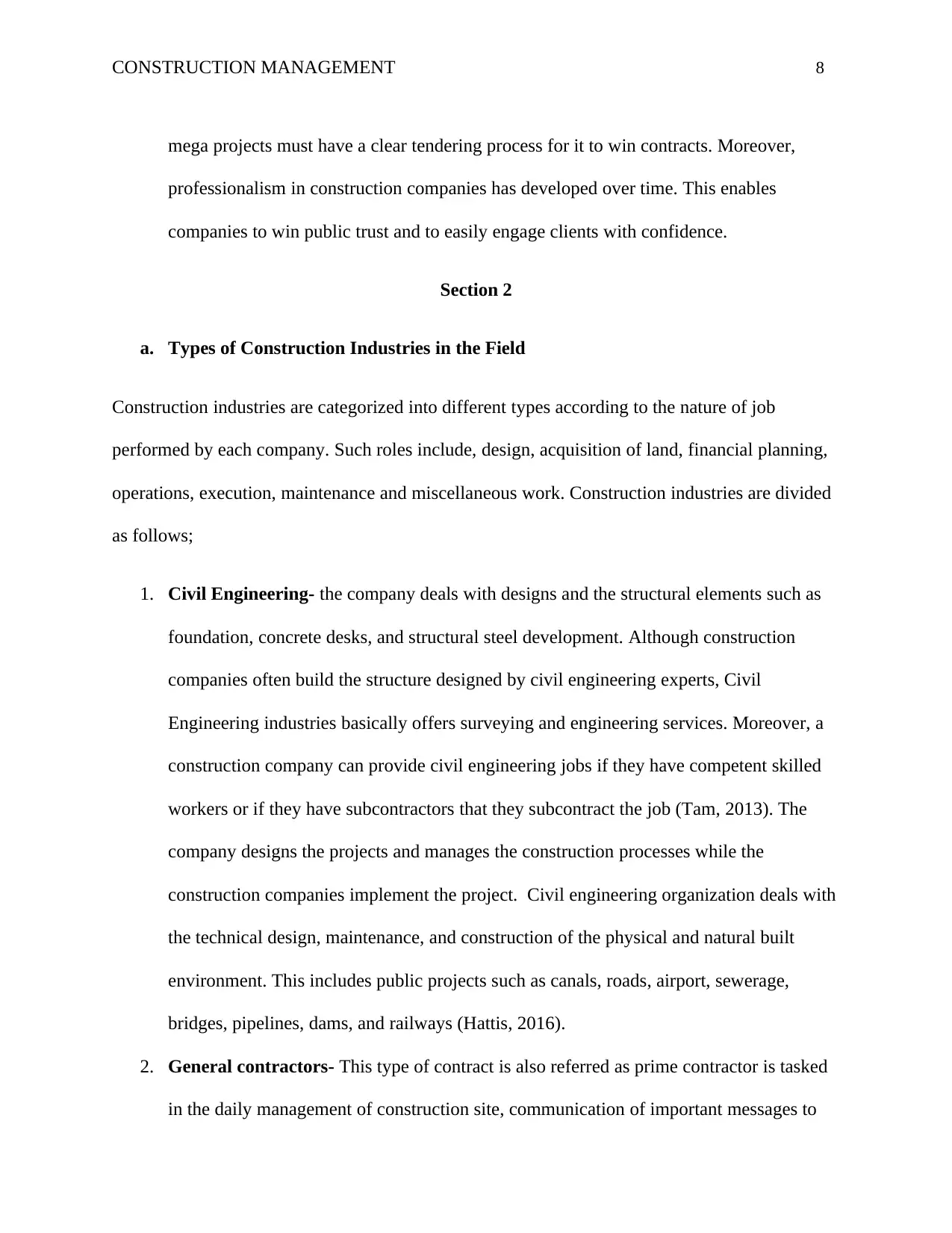
CONSTRUCTION MANAGEMENT 8
mega projects must have a clear tendering process for it to win contracts. Moreover,
professionalism in construction companies has developed over time. This enables
companies to win public trust and to easily engage clients with confidence.
Section 2
a. Types of Construction Industries in the Field
Construction industries are categorized into different types according to the nature of job
performed by each company. Such roles include, design, acquisition of land, financial planning,
operations, execution, maintenance and miscellaneous work. Construction industries are divided
as follows;
1. Civil Engineering- the company deals with designs and the structural elements such as
foundation, concrete desks, and structural steel development. Although construction
companies often build the structure designed by civil engineering experts, Civil
Engineering industries basically offers surveying and engineering services. Moreover, a
construction company can provide civil engineering jobs if they have competent skilled
workers or if they have subcontractors that they subcontract the job (Tam, 2013). The
company designs the projects and manages the construction processes while the
construction companies implement the project. Civil engineering organization deals with
the technical design, maintenance, and construction of the physical and natural built
environment. This includes public projects such as canals, roads, airport, sewerage,
bridges, pipelines, dams, and railways (Hattis, 2016).
2. General contractors- This type of contract is also referred as prime contractor is tasked
in the daily management of construction site, communication of important messages to
mega projects must have a clear tendering process for it to win contracts. Moreover,
professionalism in construction companies has developed over time. This enables
companies to win public trust and to easily engage clients with confidence.
Section 2
a. Types of Construction Industries in the Field
Construction industries are categorized into different types according to the nature of job
performed by each company. Such roles include, design, acquisition of land, financial planning,
operations, execution, maintenance and miscellaneous work. Construction industries are divided
as follows;
1. Civil Engineering- the company deals with designs and the structural elements such as
foundation, concrete desks, and structural steel development. Although construction
companies often build the structure designed by civil engineering experts, Civil
Engineering industries basically offers surveying and engineering services. Moreover, a
construction company can provide civil engineering jobs if they have competent skilled
workers or if they have subcontractors that they subcontract the job (Tam, 2013). The
company designs the projects and manages the construction processes while the
construction companies implement the project. Civil engineering organization deals with
the technical design, maintenance, and construction of the physical and natural built
environment. This includes public projects such as canals, roads, airport, sewerage,
bridges, pipelines, dams, and railways (Hattis, 2016).
2. General contractors- This type of contract is also referred as prime contractor is tasked
in the daily management of construction site, communication of important messages to
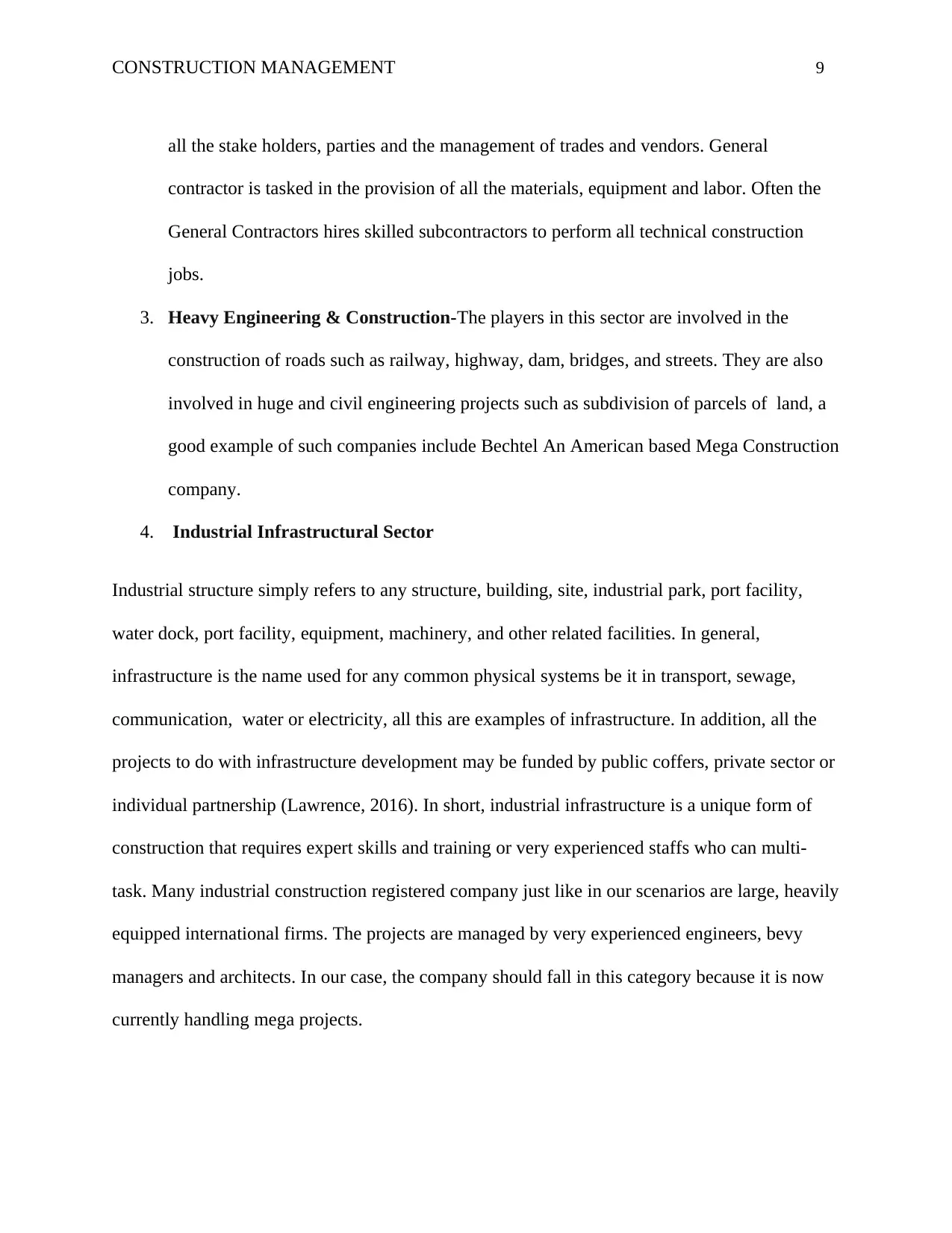
CONSTRUCTION MANAGEMENT 9
all the stake holders, parties and the management of trades and vendors. General
contractor is tasked in the provision of all the materials, equipment and labor. Often the
General Contractors hires skilled subcontractors to perform all technical construction
jobs.
3. Heavy Engineering & Construction-The players in this sector are involved in the
construction of roads such as railway, highway, dam, bridges, and streets. They are also
involved in huge and civil engineering projects such as subdivision of parcels of land, a
good example of such companies include Bechtel An American based Mega Construction
company.
4. Industrial Infrastructural Sector
Industrial structure simply refers to any structure, building, site, industrial park, port facility,
water dock, port facility, equipment, machinery, and other related facilities. In general,
infrastructure is the name used for any common physical systems be it in transport, sewage,
communication, water or electricity, all this are examples of infrastructure. In addition, all the
projects to do with infrastructure development may be funded by public coffers, private sector or
individual partnership (Lawrence, 2016). In short, industrial infrastructure is a unique form of
construction that requires expert skills and training or very experienced staffs who can multi-
task. Many industrial construction registered company just like in our scenarios are large, heavily
equipped international firms. The projects are managed by very experienced engineers, bevy
managers and architects. In our case, the company should fall in this category because it is now
currently handling mega projects.
all the stake holders, parties and the management of trades and vendors. General
contractor is tasked in the provision of all the materials, equipment and labor. Often the
General Contractors hires skilled subcontractors to perform all technical construction
jobs.
3. Heavy Engineering & Construction-The players in this sector are involved in the
construction of roads such as railway, highway, dam, bridges, and streets. They are also
involved in huge and civil engineering projects such as subdivision of parcels of land, a
good example of such companies include Bechtel An American based Mega Construction
company.
4. Industrial Infrastructural Sector
Industrial structure simply refers to any structure, building, site, industrial park, port facility,
water dock, port facility, equipment, machinery, and other related facilities. In general,
infrastructure is the name used for any common physical systems be it in transport, sewage,
communication, water or electricity, all this are examples of infrastructure. In addition, all the
projects to do with infrastructure development may be funded by public coffers, private sector or
individual partnership (Lawrence, 2016). In short, industrial infrastructure is a unique form of
construction that requires expert skills and training or very experienced staffs who can multi-
task. Many industrial construction registered company just like in our scenarios are large, heavily
equipped international firms. The projects are managed by very experienced engineers, bevy
managers and architects. In our case, the company should fall in this category because it is now
currently handling mega projects.
⊘ This is a preview!⊘
Do you want full access?
Subscribe today to unlock all pages.

Trusted by 1+ million students worldwide
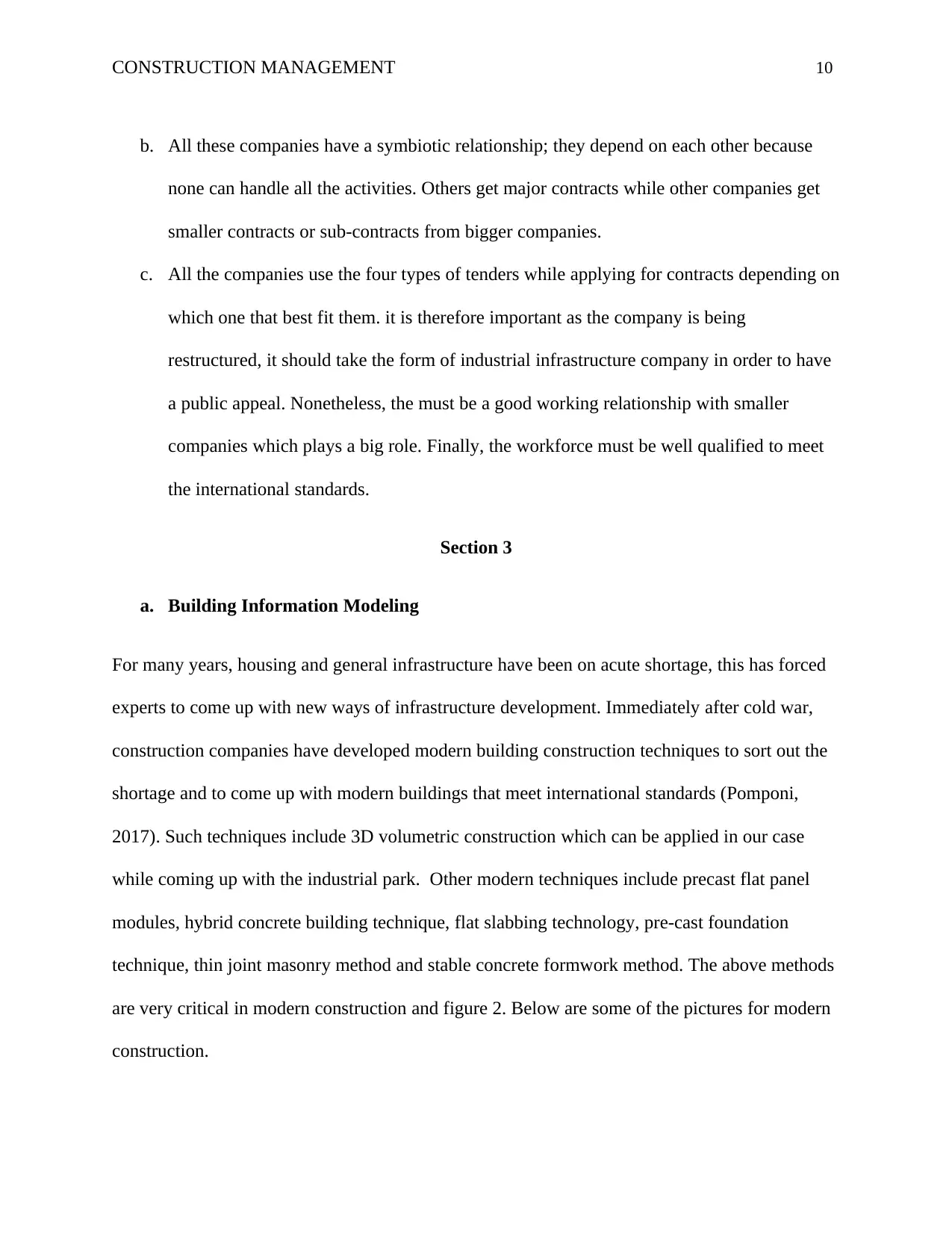
CONSTRUCTION MANAGEMENT 10
b. All these companies have a symbiotic relationship; they depend on each other because
none can handle all the activities. Others get major contracts while other companies get
smaller contracts or sub-contracts from bigger companies.
c. All the companies use the four types of tenders while applying for contracts depending on
which one that best fit them. it is therefore important as the company is being
restructured, it should take the form of industrial infrastructure company in order to have
a public appeal. Nonetheless, the must be a good working relationship with smaller
companies which plays a big role. Finally, the workforce must be well qualified to meet
the international standards.
Section 3
a. Building Information Modeling
For many years, housing and general infrastructure have been on acute shortage, this has forced
experts to come up with new ways of infrastructure development. Immediately after cold war,
construction companies have developed modern building construction techniques to sort out the
shortage and to come up with modern buildings that meet international standards (Pomponi,
2017). Such techniques include 3D volumetric construction which can be applied in our case
while coming up with the industrial park. Other modern techniques include precast flat panel
modules, hybrid concrete building technique, flat slabbing technology, pre-cast foundation
technique, thin joint masonry method and stable concrete formwork method. The above methods
are very critical in modern construction and figure 2. Below are some of the pictures for modern
construction.
b. All these companies have a symbiotic relationship; they depend on each other because
none can handle all the activities. Others get major contracts while other companies get
smaller contracts or sub-contracts from bigger companies.
c. All the companies use the four types of tenders while applying for contracts depending on
which one that best fit them. it is therefore important as the company is being
restructured, it should take the form of industrial infrastructure company in order to have
a public appeal. Nonetheless, the must be a good working relationship with smaller
companies which plays a big role. Finally, the workforce must be well qualified to meet
the international standards.
Section 3
a. Building Information Modeling
For many years, housing and general infrastructure have been on acute shortage, this has forced
experts to come up with new ways of infrastructure development. Immediately after cold war,
construction companies have developed modern building construction techniques to sort out the
shortage and to come up with modern buildings that meet international standards (Pomponi,
2017). Such techniques include 3D volumetric construction which can be applied in our case
while coming up with the industrial park. Other modern techniques include precast flat panel
modules, hybrid concrete building technique, flat slabbing technology, pre-cast foundation
technique, thin joint masonry method and stable concrete formwork method. The above methods
are very critical in modern construction and figure 2. Below are some of the pictures for modern
construction.
Paraphrase This Document
Need a fresh take? Get an instant paraphrase of this document with our AI Paraphraser
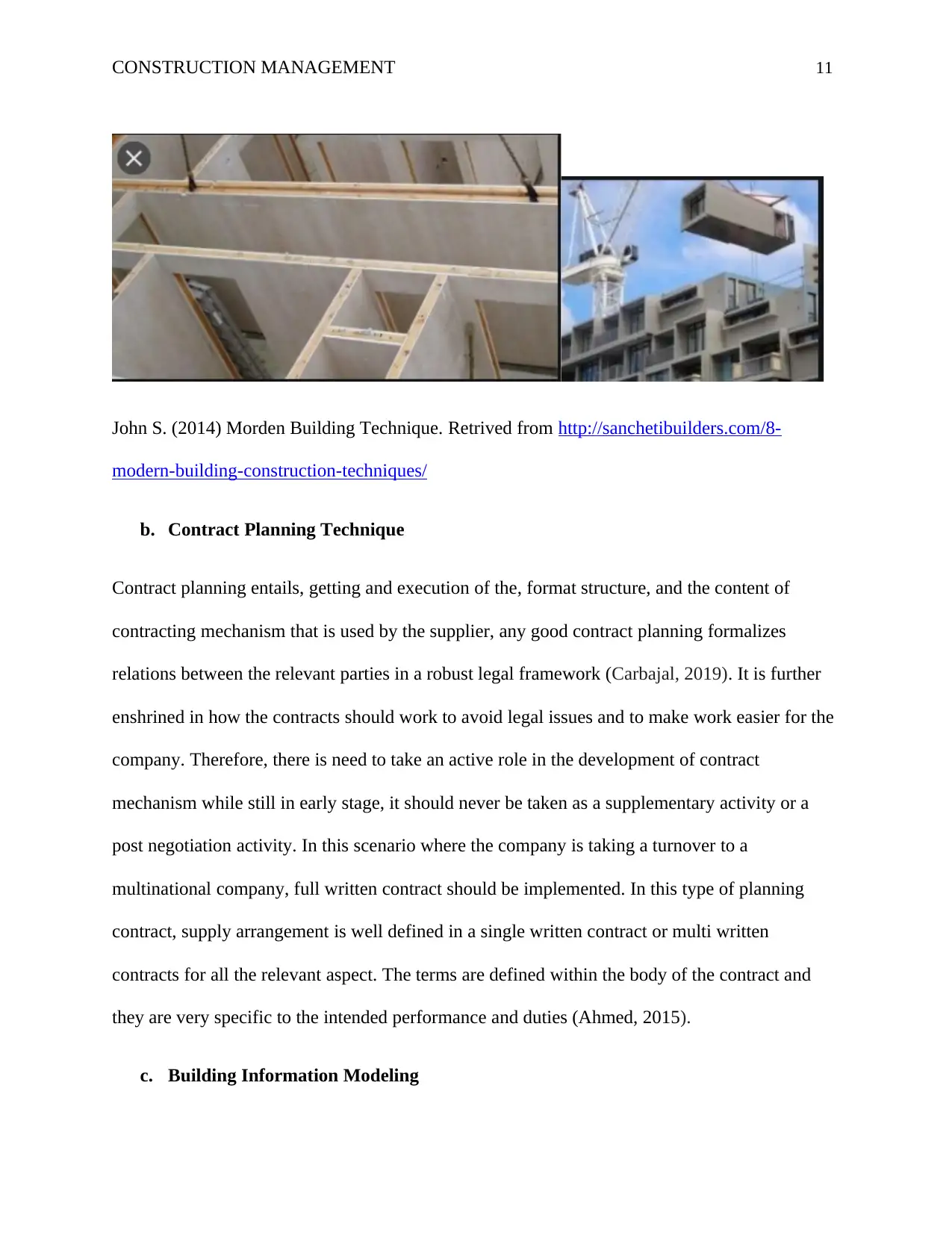
CONSTRUCTION MANAGEMENT 11
John S. (2014) Morden Building Technique. Retrived from http://sanchetibuilders.com/8-
modern-building-construction-techniques/
b. Contract Planning Technique
Contract planning entails, getting and execution of the, format structure, and the content of
contracting mechanism that is used by the supplier, any good contract planning formalizes
relations between the relevant parties in a robust legal framework (Carbajal, 2019). It is further
enshrined in how the contracts should work to avoid legal issues and to make work easier for the
company. Therefore, there is need to take an active role in the development of contract
mechanism while still in early stage, it should never be taken as a supplementary activity or a
post negotiation activity. In this scenario where the company is taking a turnover to a
multinational company, full written contract should be implemented. In this type of planning
contract, supply arrangement is well defined in a single written contract or multi written
contracts for all the relevant aspect. The terms are defined within the body of the contract and
they are very specific to the intended performance and duties (Ahmed, 2015).
c. Building Information Modeling
John S. (2014) Morden Building Technique. Retrived from http://sanchetibuilders.com/8-
modern-building-construction-techniques/
b. Contract Planning Technique
Contract planning entails, getting and execution of the, format structure, and the content of
contracting mechanism that is used by the supplier, any good contract planning formalizes
relations between the relevant parties in a robust legal framework (Carbajal, 2019). It is further
enshrined in how the contracts should work to avoid legal issues and to make work easier for the
company. Therefore, there is need to take an active role in the development of contract
mechanism while still in early stage, it should never be taken as a supplementary activity or a
post negotiation activity. In this scenario where the company is taking a turnover to a
multinational company, full written contract should be implemented. In this type of planning
contract, supply arrangement is well defined in a single written contract or multi written
contracts for all the relevant aspect. The terms are defined within the body of the contract and
they are very specific to the intended performance and duties (Ahmed, 2015).
c. Building Information Modeling
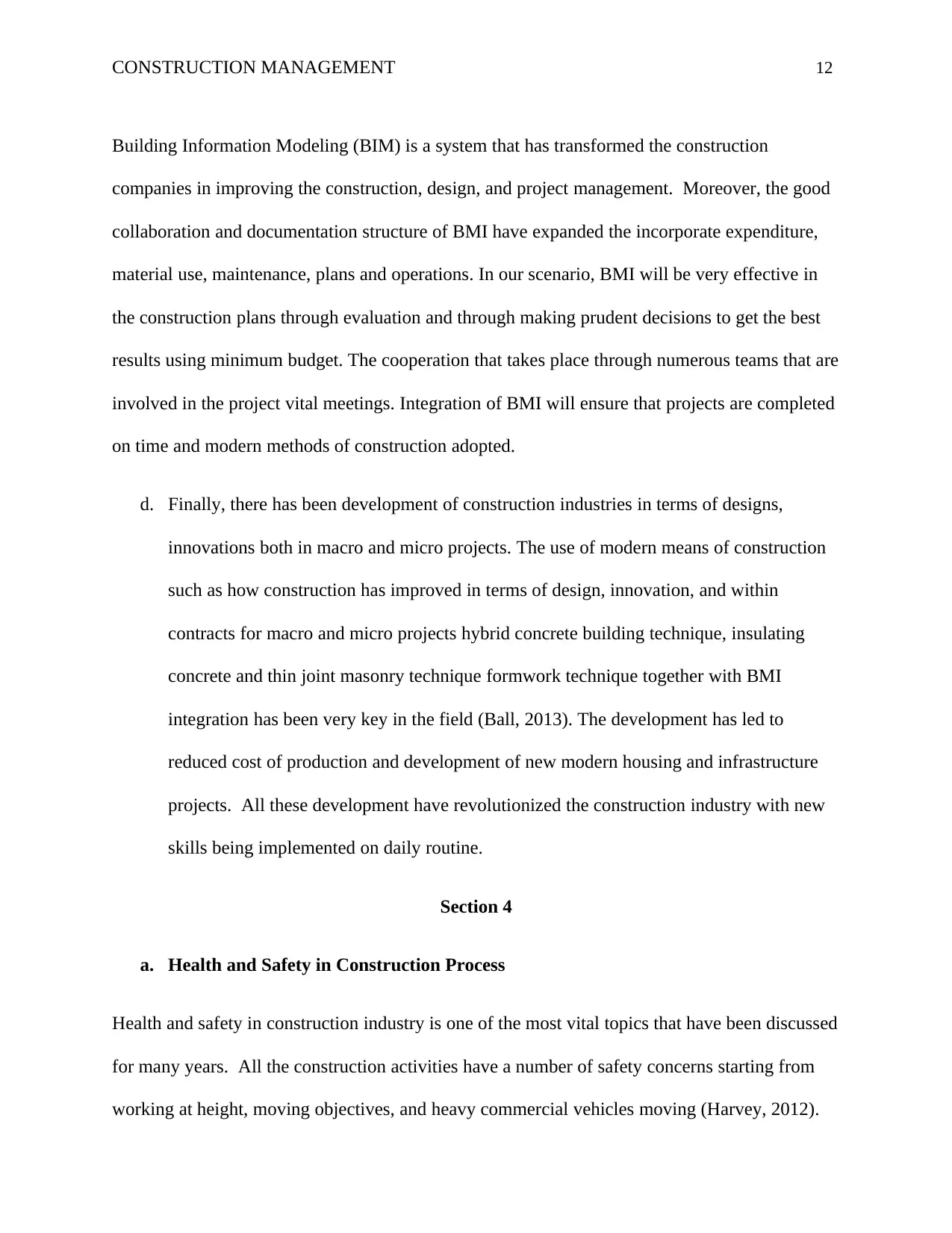
CONSTRUCTION MANAGEMENT 12
Building Information Modeling (BIM) is a system that has transformed the construction
companies in improving the construction, design, and project management. Moreover, the good
collaboration and documentation structure of BMI have expanded the incorporate expenditure,
material use, maintenance, plans and operations. In our scenario, BMI will be very effective in
the construction plans through evaluation and through making prudent decisions to get the best
results using minimum budget. The cooperation that takes place through numerous teams that are
involved in the project vital meetings. Integration of BMI will ensure that projects are completed
on time and modern methods of construction adopted.
d. Finally, there has been development of construction industries in terms of designs,
innovations both in macro and micro projects. The use of modern means of construction
such as how construction has improved in terms of design, innovation, and within
contracts for macro and micro projects hybrid concrete building technique, insulating
concrete and thin joint masonry technique formwork technique together with BMI
integration has been very key in the field (Ball, 2013). The development has led to
reduced cost of production and development of new modern housing and infrastructure
projects. All these development have revolutionized the construction industry with new
skills being implemented on daily routine.
Section 4
a. Health and Safety in Construction Process
Health and safety in construction industry is one of the most vital topics that have been discussed
for many years. All the construction activities have a number of safety concerns starting from
working at height, moving objectives, and heavy commercial vehicles moving (Harvey, 2012).
Building Information Modeling (BIM) is a system that has transformed the construction
companies in improving the construction, design, and project management. Moreover, the good
collaboration and documentation structure of BMI have expanded the incorporate expenditure,
material use, maintenance, plans and operations. In our scenario, BMI will be very effective in
the construction plans through evaluation and through making prudent decisions to get the best
results using minimum budget. The cooperation that takes place through numerous teams that are
involved in the project vital meetings. Integration of BMI will ensure that projects are completed
on time and modern methods of construction adopted.
d. Finally, there has been development of construction industries in terms of designs,
innovations both in macro and micro projects. The use of modern means of construction
such as how construction has improved in terms of design, innovation, and within
contracts for macro and micro projects hybrid concrete building technique, insulating
concrete and thin joint masonry technique formwork technique together with BMI
integration has been very key in the field (Ball, 2013). The development has led to
reduced cost of production and development of new modern housing and infrastructure
projects. All these development have revolutionized the construction industry with new
skills being implemented on daily routine.
Section 4
a. Health and Safety in Construction Process
Health and safety in construction industry is one of the most vital topics that have been discussed
for many years. All the construction activities have a number of safety concerns starting from
working at height, moving objectives, and heavy commercial vehicles moving (Harvey, 2012).
⊘ This is a preview!⊘
Do you want full access?
Subscribe today to unlock all pages.

Trusted by 1+ million students worldwide
1 out of 17
Related Documents
Your All-in-One AI-Powered Toolkit for Academic Success.
+13062052269
info@desklib.com
Available 24*7 on WhatsApp / Email
![[object Object]](/_next/static/media/star-bottom.7253800d.svg)
Unlock your academic potential
Copyright © 2020–2025 A2Z Services. All Rights Reserved. Developed and managed by ZUCOL.





